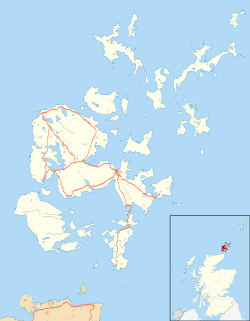Quanterness chambered cairn facts for kids

View toward Quanterness Farm and Wideford Hill
|
|
| Location | Mainland, Orkney, Scotland |
|---|---|
| Coordinates | 59°00′03″N 3°00′56″W / 59.00092°N 3.01564°W |
| Type | Chambered cairn |
| History | |
| Founded | 3400 BC |
| Periods | Neolithic |
| Site notes | |
| Ownership | Historic Scotland |
| Public access | Yes |
The Quanterness chambered cairn is an ancient burial place in Scotland. It is found on Mainland, Orkney, an island in the north. This monument was built during the Neolithic period, which was a very long time ago.
During digs in the 1970s, archaeologists found something amazing. They discovered an Iron Age roundhouse built right into the cairn. This house was made around 700 BC. They also found the bones of 157 people, pieces of pottery, and other old items. In 1929, Historic Environment Scotland made this site a special protected place.
Contents
Where is Quanterness Cairn?
The Quanterness chambered cairn is located on Mainland, Orkney in Scotland. It sits at the bottom of the north side of Wideford Hill. It is also north-east of the Wideford Hill chambered cairn.
From the site, you can see the North Isles. This tomb is one of three ancient cairns found between Kirkwall and Finstown. The land where the tomb is located is private. This means it is not open for everyone to visit.
What Does the Cairn Look Like?
Today, the cairn looks like a big mound covered in grass. It is about 30 meters wide and 3.2 meters tall. Inside this mound are two main parts. There is a Neolithic burial monument and an Iron Age roundhouse.
A long passage led into the cairn from the east side. This passage opened into a large main room. This room was about 6.5 meters long, 1.9 meters wide, and 3.5 meters high. The main room was shaped like a rectangle. It had two smaller rooms on each side and one at each end.
This cairn is a special type called a Maeshowe chambered cairn. Scientists used radiocarbon dating to find out when it was built. They believe it was constructed around 3400 BC. One interesting thing about this tomb is a small opening. It is like a window into one of the smaller rooms from the main chamber. This opening might have been used for important ceremonies.
Who Explored Quanterness Cairn?
The first person to dig into the burial monument was Reverend George Barry. He explored it around 1796. He got in by going through the roof of the monument. At that time, the mound was shaped like a cone with a flat top. It was about 4.27 meters high.
The tomb had a main room and several smaller rooms. People tried to dig through the long entrance passage, but it was filled with rubble. They stopped after digging about 4.27 meters. The floor of the main room was covered with bones. These were from humans, animals, and birds. They were mixed with soil and rocks.
The site was not dug up again until 1972. From 1972 to 1974, an archaeologist named Colin Renfrew studied the monument. He wanted to learn more about the inside of the mound. He also wanted to find old materials for radiocarbon dating. His work showed that the mound covered a rectangular room. This room had six smaller rooms on its sides.
He found many human bones, about 12,500 pieces. He also found pottery and other old items. Near the entrance passage, a circular building was found. This was later identified as an Iron Age roundhouse. This roundhouse was probably built around 700 BC. Renfrew left much of the tomb and its contents untouched. He also left part of the roundhouse for future studies.
Scientists studied the bones that were dug up. They found that 157 people were buried there. Other parts of the tomb were not dug up. Experts think that possibly 400 people might be buried in this monument. The pieces of pottery found belonged to at least 34 Grooved ware pots. Other items found include hammerstones, flint knives, bone pins, and a hammer made from an antler. Historic Environment Scotland made this site a protected monument in 1929.
See also


